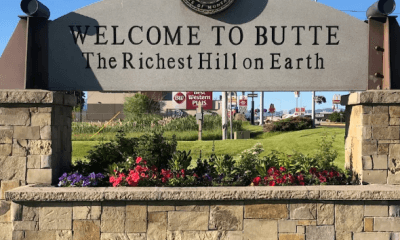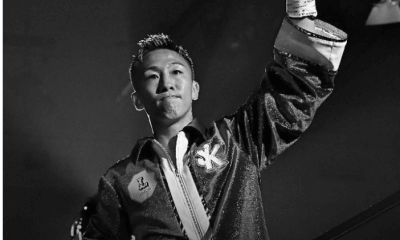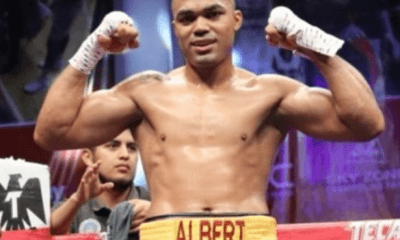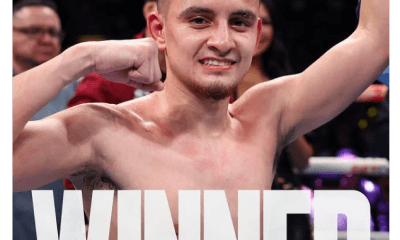Featured Articles
McGovern vs. Palmer: The First Big International Prizefight on American Soil
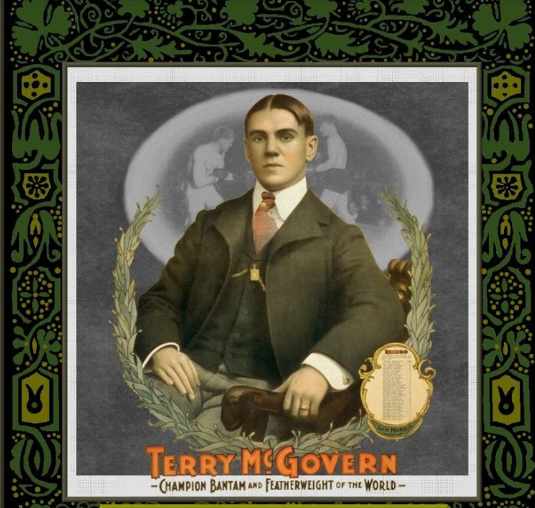
If asked to name the first big international prizefight on American soil, most boxing historians would name the 1921 match between Jack Dempsey and Georges Carpentier, the idol of France. It’s hard to disagree. Dempsey’s heavyweight title was at stake and the event was a grand spectacle, attracting a crowd of more than 80,000, begetting the sport’s first million-dollar gate. However, 22 years earlier a match-up between Terry McGovern and Pedlar Palmer attracted considerable buzz and the event organizers contorted it into a spectacle by packaging it with frills that became standard pomp for international mega-fights.
Terrible Terry McGovern stood only five-foot-three and his best weight was a shade under 120 pounds. But my how he could hit. The noted boxing referee and pugilistic authority Charley White said of McGovern that he was a thunderstorm, a Krupp cannon and a Gatling gun all at the same time. Prominent boxing writer Robert Edgren said, “No other man in his class ever developed anything approaching his tremendous burst of fighting energy, his tremendous aggressiveness and his terrific punching power.”
When Jack Dempsey started concussing opponents left and right, it was said that he was a larger version of Terry McGovern, a supreme compliment.
McGovern had suffered only two defeats prior to meeting Pedlar Palmer, both by disqualification. He was in excellent form, having won 13 straight, 11 by KO. His knockout victims included top-notchers Harry Forbes, the pride of Chicago, Austin Rice, the Connecticut Iron Man, and Casper Leon, the Sicilian Swordfish. McGovern was recognized as the American bantamweight champion.
Born in 1880, Terry was six months old when his parents moved from Johnstown, Pennsylvania to Brooklyn, beating the great flood by nine years. The Brooklyn of Terry’s boyhood was America’s fourth largest city, a distinction it lost in 1898 when it was consolidated with the boroughs of Queens, the Bronx, and Staten Island into the modern city of New York.
Brooklyn’s poster boy circa 1880 was Henry Ward Beecher, the pastor of Brooklyn’s Plymouth Congregational Church. A spellbinding orator, Beecher was America’s first great celebrity preacher; his sermons ran in dozens of major newspapers and anthologies of them out-sold popular fiction.
His fame was such that Brooklyn, in the eyes of outsiders, was perceived to be an overwhelmingly WASPish community. But the reality was different. By 1860, half the population was foreign born and half of that was Irish Catholic. And the Irish, with their knack for political organizing, soon dominated the political life of the city.
While Brooklyn’s Protestant clergymen condemned prizefighting from their pulpits, the city nonetheless developed a robust prizefighting subculture. Several bare-knuckle title claimants spent their formative years in Brooklyn, as did the first Jack Dempsey, the Nonpareil, an important transitional fighter as the sport moved into the gloved era.
McGovern was 18 years old when he engaged in his first 20-round fight. His performance caught the eye of Sam H. Harris, an ambitious young man then in his mid-20s. Harris arranged to be become Terry’s manager and proved to be an excellent fit. Then, as now, no matter how talented a boxer, he wasn’t going far without a well-connected manager. (Harris went on to have an illustrious career on Broadway, producing or co-producing 130 shows including many of Broadway’s biggest hits.)
Brooklyn in McGovern’s day, although a patchwork of ethnic enclaves, had an esprit-de-corps, a sense of togetherness that welded the populace into a tighter community. Among current Brooklyn boxers, none has a more avid fan base than Adam Kownacki. Take Kownacki’s level of popularity and multiply it several times over and that was Terrible Terry McGovern.
Pedlar Palmer
Thomas “Pedlar” Palmer grew up in a circus family. He was an acrobat who developed a novelty act in tandem with his brother. He took up boxing at age 15 and was performing at the National Sporting Club while still in his teens. He had 16 fights at the NSC before sailing off to the U.S. to keep his date with McGovern. Six of those fights were billed for the world bantamweight title, a division with no firm ceiling, fluctuating between 112 and 118 pounds. He never lost.
To a young British boxer, nothing matched the prestige of fighting at the National Sporting Club. The exclusive men’s club in London’s fashionable Covent Garden district was patronized by the crème-de-la-crème of London’s entrepreneurial class. They watched the fights in formal evening attire while adhering to a strict code of decorum that prohibited shouting. The Queensberry rules weren’t invented here, but were firmly applied here (with a few modifications), a big step toward universal acceptance. The NSC was the precursor of the British Boxing Board of Control.
The president of the National Sporting Club was the fabulous Earl of Lonsdale, but the day-to-day affairs of the club, and the matchmaking, were in the hands of A.F. “Peggy” Bettinson. A former English amateur lightweight champion, the autocratic Bettinson enforced the rules of the club with an iron fist.
Bettinson took a pecuniary interest in Pedlar Palmer, becoming his manager.
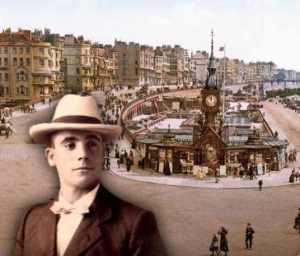
Palmer (pictured against the backdrop of Brighton, the seaside resort city where he lived and trained) was reportedly illiterate, but his ring IQ, reflected in his nickname, “Box-o’-Tricks,” was off the charts. “He fights according to the style of his opponent and never fights two men the same way,” noted a British writer. “Quick and agile as a cat, he is here, there, and everywhere, putting into execution more dodges and expedients than two ordinary men,” said a leading boxing authority.
When Pedlar Palmer and “Peggy” Bettinson arrived in New York from London, a brass band was waiting at the pier to greet them. The following day, the fighter and his manager were feted with a banquet at their hotel.
The Venue
McGovern vs. Palmer was staged in an outdoor arena in Tuckahoe, a little village in Westchester County, 16 miles from midtown Manhattan and 22 minutes by train from Manhattan’s Grand Central depot. The arena, which was enclosed by a wooden fence, was situated directly across from Tuckahoe’s new railroad station. The land sloped gently down to where the ring was pitched. Situated in the back, roughly 100 yards from the ring, were two cottages that were deployed as dressing rooms. They had windows that looked down on the enclosure. Terry McGovern’s young wife stayed in one of the cottages with their two-month-old baby. She would not have been welcome at ringside as it was taboo for a woman to attend a prizefight.
The crowd at the Sept. 12, 1899 fight was variously estimated at 8,000 to 12,000. Nowadays, this would hardly be considered a large crowd, but it was a large crowd for this era; an era when the law restricted prizefights to property owned or leased by an athletic club. The attendance would have been larger if the bout had gone off the previous day as scheduled as that was a Monday and the racetracks would have been dark. Racetrack workers and racetrack denizens, by and large, were big fight fans. Unfortunately for the promoters, rain pushed the fight back one day where it went head-to-head with the opening day of the autumn meet at the Gravesend track in Coney Island.
In those days, the indicator of a mega-fight wasn’t how many people were there, but who was there and McGovern vs. Palmer attracted a who’s-who of luminaries from the fields of sports and entertainment plus seemingly every person of influence in Tammany Hall, New York City’s corrupt political machine. Special trains carrying fight fans arrived from Boston, Providence, Hartford, Philadelphia and Buffalo.
The pugilistic contingent, said a reporter, included every boxer of note, “from the top-notchers in the heavyweight division to the paper weights in the amateur ranks.” The list included John L. Sullivan, who received the loudest ovation as he came down the aisle, James J. Corbett, Tom Sharkey, Bob Fitzsimmons and Kid McCoy. The British delegation included grocery chain magnate Sir Thomas Lipton, the famous yacht racer whose name would be immortalized in a popular brand of tea.
In those days, the lion’s share of the large wagers on a big fight were made in the arena through so-called betting commissioners. The commissioners filled orders, betting “x” amount of dollars at specified odds if they were able to obtain those odds. Bets by prominent people were a staple of post-fight stories. With no federal income tax, a gambler had less reason to be discreet.
McGovern was favored. Odds of 10/8 were widely available as the arena was filling up, lengthening to 10/7 as the bout drew closer to its mid-afternoon starting time. The well-known bandleader John Phillip Sousa was no greenhorn when it came to getting the best of it. He reportedly risked $300 on McGovern to win $275.
The Preamble and the Fight
The Revolutionary War was old history, but there was still a trace of hard feeling between the two nations and the promoters seized upon it to ratchet up the drama.
Pedlar Palmer appeared first. Someone in his cottage signaled the band to strike up “God Save The Queen” and the anthem accompanied him as he made his walk to the ring behind a man holding aloft the British flag.
After Palmer climbed through the ropes, the band struck up “The Star Spangled Banner,” McGovern’s cue to begin his ring walk. Twelve-year-old Phil McGovern, the youngest of Terry’s two younger brothers, led the way, carrying the American flag. The fellow at the back of the procession waved the green flag of Ireland with its golden harp.
According to the correspondent for the New York World, when McGovern slipped through the ropes the cheer was deafening, reverberating in the hills miles away. The combatants were then gloved in the ring, as was the custom, and then went at it in one of the most anti-climatic fights in the history of the prize ring. It was all over in 152 seconds and that included the unscheduled 12-second break when the hammer slipped out of the timekeeper’s hands and he rang the bell by mistake.
Before the bout was 90 seconds old, Palmer was on the canvas, deposited there by a right-left combination. He got up but looked woozy and McGovern moved in for the kill. But he was over-anxious and Palmer was able to dodge his punches until he succeeded in tying him up. But as soon as the referee pried them apart, McGovern resumed his attack, snapping Palmer’s head back with a left to the jaw that sent him staggering toward the ropes and then putting him down for the count with a straight right hand to the point of the jaw. “America Forever: Knocks Out England in One Round,” read the headline above the Associated Press dispatch in the next day’s Los Angeles Times.
McGovern was mobbed as he left the ring. The horseshoe-shaped floral arrangement that was presented to him after the fight was robbed of all its flowers by souvenir-hunters. Back in Brooklyn, the scene was even more tumultuous.
According to the Brooklyn Daily Eagle, bonfires were kindled and fireworks in large quantities were set off as McGovern alighted from the streetcar, holding his baby in his arms with his wife at his side. With much difficulty, the police cleared a path to his residence. The McGoverns then resided in an apartment above a saloon that he had recently purchased. Downstairs, the saloon was mobbed and so much money was going across the bar, said the paper, that it seemed as if everyone in the neighborhood had won something.
The Aftermath
Terry McGovern’s star shone even brighter the following year. In 1900, he added the world featherweight belt to his laurels with an eighth-round stoppage of long-reigning title-holder George Dixon, stopped the formidable Oscar Gardner, the Omaha Kid, in three rounds, and needed only three rounds to put away lightweight champion Frank Erne in their non-title fight. He also became a big attraction on the vaudeville circuit, eventually assuming the lead role in the hokey melodrama (that’s redundant) “The Bowery After Dark.” McGovern played the hero, the fellow that gets to rescue the damsel in distress.
On Thanksgiving Day, 1901, in a mammoth upset, McGovern was knocked out cold in the second round by Young Corbett II (born William Rothwell), an unheralded fighter from Denver. Terrible Terry was never the same and washed out of the sport while still in his twenties. He was in and out of sanitariums the last few years of his life and exhibiting signs of dementia when he died of pneumonia at age 37. As for Pedlar Palmer, he returned to England and recaptured the bantamweight title after McGovern abandoned it, but he lost the title in his first defense and gradually became just another name fighter playing out the string, earning his largest paydays in bouts where he served as a building block for young fighters on the rise. He died at age 73 in Brighton.
—-
In searching for a parallel to McGovern-Palmer, Mike Tyson’s 91-second blowout of Michael Spinks at Atlantic City in 1988 jumped quickly to mind. Akin to McGovern-Palmer it was a match between a slugger and a clever boxer. The slugger was favored but not overwhelmingly so. It too was a unification fight: Tyson held the belts of all three major sanctioning bodies, but Spinks, who had been stripped by the IBF, had a stronger claim to the lineal heavyweight title. The bout attracted enormous buzz, drew a celebrity-studded crowd, and the victor, who never let the clever boxer display his wares, experienced a big spike in his famousness.
Tyson vs. Spinks attracted a crowd of roughly 22,000. A far more intimate gathering witnessed Terry McGovern’s fast demolition of Pedlar Palmer, but yet, as measured by goose pimples, it was every bit as spectacular. I wish that I had been there.
Check out more boxing news on video at The Boxing Channel
To comment on this story in The Fight Forum CLICK HERE
-

 Featured Articles3 weeks ago
Featured Articles3 weeks agoThe Hauser Report: Zayas-Garcia, Pacquiao, Usyk, and the NYSAC
-

 Featured Articles2 weeks ago
Featured Articles2 weeks agoOscar Duarte and Regis Prograis Prevail on an Action-Packed Fight Card in Chicago
-

 Featured Articles1 week ago
Featured Articles1 week agoThe Hauser Report: Cinematic and Literary Notes
-

 Book Review4 days ago
Book Review4 days agoMark Kriegel’s New Book About Mike Tyson is a Must-Read
-

 Featured Articles4 weeks ago
Featured Articles4 weeks agoManny Pacquiao and Mario Barrios Fight to a Draw; Fundora stops Tim Tszyu
-

 Featured Articles4 weeks ago
Featured Articles4 weeks agoArne’s Almanac: Pacquiao-Barrios Redux
-

 Featured Articles3 weeks ago
Featured Articles3 weeks agoRemembering Dwight Muhammad Qawi (1953-2025) and his Triumphant Return to Prison
-
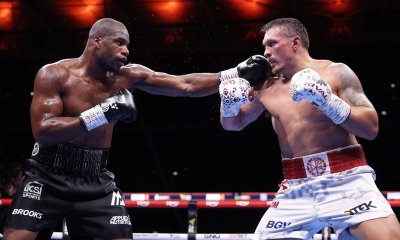
 Featured Articles4 weeks ago
Featured Articles4 weeks agoOleksandr Usyk Continues to Amaze; KOs Daniel Dubois in 5 One-Sided Rounds




